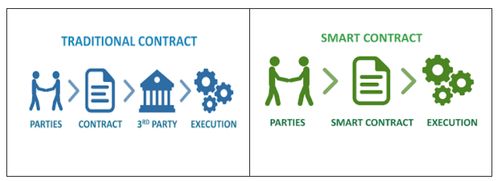Smart Contracts vs. Traditional Contracts: A Comparative Analysis
Smart Contracts vs. Traditional Contracts: A Comparative Analysis of Legal Implications
 The realm of contracts is undergoing a significant transformation with the emergence of blockchain technology and smart contracts. While traditional contracts have served as the foundation of legal agreements for centuries, smart contracts offer a new paradigm for automated and decentralized transactions. This article delves into a comparative analysis of these two approaches, highlighting their key features and the legal implications that arise from their implementation.
The realm of contracts is undergoing a significant transformation with the emergence of blockchain technology and smart contracts. While traditional contracts have served as the foundation of legal agreements for centuries, smart contracts offer a new paradigm for automated and decentralized transactions. This article delves into a comparative analysis of these two approaches, highlighting their key features and the legal implications that arise from their implementation.
Traditional Contracts: The Cornerstone of Agreements
Traditional contracts are written agreements outlining the rights and obligations of the involved parties. They are typically drafted in natural language, requiring interpretation and potentially leading to disputes due to ambiguity. The enforcement of these contracts relies on the legal system, with courts playing a crucial role in settling disagreements. Traditional contracts often involve intermediaries like lawyers and notaries, adding to the cost and complexity of the process.Smart Contracts: Automation on the Blockchain
Smart contracts, on the other hand, are self-executing programs stored on a blockchain, a distributed ledger technology. Written in code, they define the terms of an agreement and automatically execute its provisions when predetermined conditions are met. This eliminates the need for intermediaries and human intervention, promoting efficiency and transparency.
Key Differences and Legal Considerations
Several key distinctions between smart contracts and traditional contracts carry significant legal implications:
- Formation: Traditional contracts require mutual assent, offer, and acceptance, which can be proven through written documents or witness testimonies. Smart contracts rely on code execution, and their formation hinges on the validity of the code itself.
- Interpretation: Traditional contracts are interpreted based on the intent of the parties, which can be subjective. Smart contracts, being code-based, are interpreted objectively, eliminating ambiguity. However, bugs or loopholes in the code can lead to unintended consequences.
- Enforcement: Traditional contracts are enforced by courts, which can issue judgments and order remedies. Smart contracts self-execute on the blockchain, and enforcement is automatic. However, legal challenges may arise regarding the enforceability of code-driven outcomes in traditional court systems.
- Modification: Traditional contracts can be modified through amendments, which require the agreement of all parties. Smart contracts, once deployed, are generally immutable. Amending them might require a complex process depending on the specific blockchain platform.
The Future of Contracts: A Hybrid Approach?
While smart contracts offer numerous advantages, they are not a silver bullet. Their current limitations, such as the inflexibility of code and the challenges of legal recourse, necessitate a cautious approach. The future of contracts might lie in a hybrid model, leveraging the strengths of both traditional and smart contracts. Traditional contracts can be used to establish the overall framework of an agreement, while smart contracts can automate specific aspects for efficient execution.
Conclusion
The emergence of smart contracts presents a fascinating development in the legal landscape. As the technology matures and legal frameworks adapt, smart contracts have the potential to revolutionize the way we conduct business and enforce agreements. However, a thorough understanding of their legal implications remains paramount for all parties involved.
References
- ^ Jump up to:
- a b Röscheisen, Martin; Baldonado, Michelle; Chang, Kevin; Gravano, Luis; Ketchpel, Steven; Paepcke, Andreas (1998). "The Stanford InfoBus and its service layers: Augmenting the internet with higher-level information management protocols". Digital Libraries in Computer Science: The MeDoc Approach. Lecture Notes in Computer Science. Vol. 1392. Springer. pp. 213–230. doi:10.1007/bfb0052526. ISBN 978-3-540-64493-4.
- ^ Jump up to:
- a b Fries, Martin; P. Paal, Boris (2019). Smart Contracts (in German). Mohr Siebeck. ISBN 978-3-16-156911-1. JSTOR j.ctvn96h9r.
- ^ Jump up to:
- a b Savelyev, Alexander (14 December 2016). "Contract Law 2.0: "Smart" Contracts As the Beginning of the End of Classic Contract Law". Social Science Research Network. SSRN 2885241.
- ^ Tapscott, Don; Tapscott, Alex (May 2016). The Blockchain Revolution: How the Technology Behind Bitcoin is Changing Money, Business, and the World. Portfolio/Penguin. pp. 72, 83, 101, 127. ISBN 978-0670069972.
- ^ Szabo, Nick (1997). "View of Formalizing and Securing Relationships on Public Networks | First Monday". First Monday. doi:10.5210/fm.v2i9.548. S2CID 33773111.
- ^ Zhou, Haozhe; Milani Fard, Amin; Makanju, Adetokunbo (2022-05-27). "The State of Ethereum Smart Contracts Security: Vulnerabilities, Countermeasures, and Tool Support". Journal of Cybersecurity and Privacy. 2 (2): 358–378. doi:10.3390/jcp2020019. ISSN 2624-800X.
- ^ "All You Need to Know About NFT Smart Contracts". Binance.com. Binance. Retrieved 26 September 2022.



































